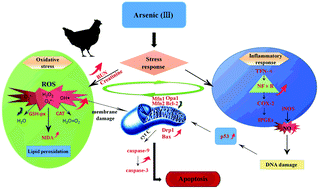Arsenite renal apoptotic effects in chickens co-aggravated by oxidative stress and inflammatory response†
Abstract
The kidney is the most crucial site for the excretion of arsenic and its metabolites. In this study, Hy-line chickens exposed to different toxicologically relevant doses of arsenic (0, 7.5, 15 and 30 mg kg−1 diet) presented marked renal injury as evidenced by the increased leakage of blood urea nitrogen (up to 2.6 folds) and creatinine (up to 2.3 folds). Furthermore, increased content of renal arsenic (up to 30 folds) and malondialdehyde restrained anti-hydroxyl radical ability, and the activities of antioxidant enzymes (glutathione peroxidase, catalase) further corroborated extensive renal damage. Meanwhile, as another cellular adaptive survival strategy, inflammation responses were quickly detected upon arsenic exposure as evidenced by elevated nuclear migration of nuclear factor-κB (NF-κB) and inflammation-related phenotypes. It was further noted that arsenic-induced mitochondrial damage was accompanied by accumulation of p53 initiated mitochondrial apoptosis pathway in nephrocyte, eventually elevating the apoptosis rate (up to 9.1 folds) compared to that of the control groups. Noticeably, correlation analysis illustrated that this mitochondrial apoptotic pathway was initiated following oxidative stress and inflammatory response. This study demonstrated that As2O3 exposure induced oxidative stress and inflammatory-mediated nephrotoxicity in a dose- and time-dependent manner, eventually leading to apoptosis through a mitochondria-dependent pathway in chicken kidneys.



 Please wait while we load your content...
Please wait while we load your content...